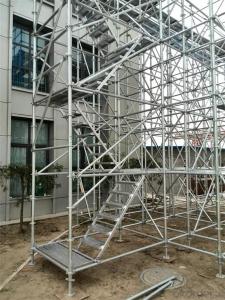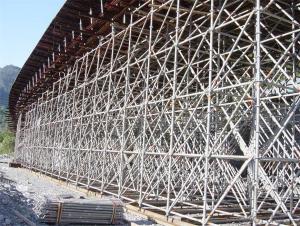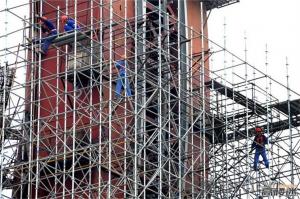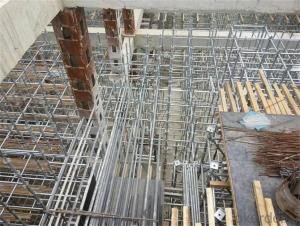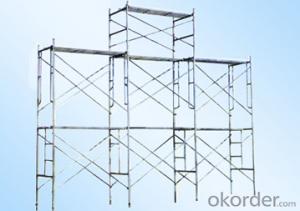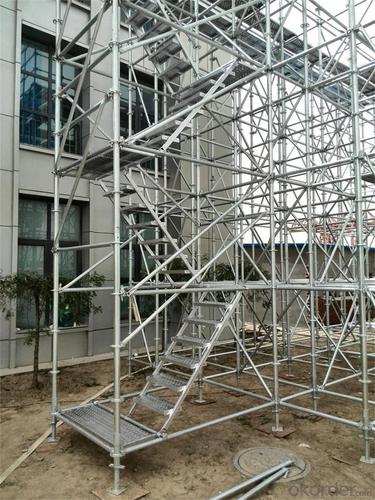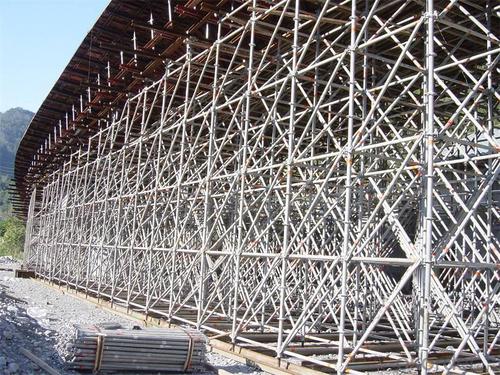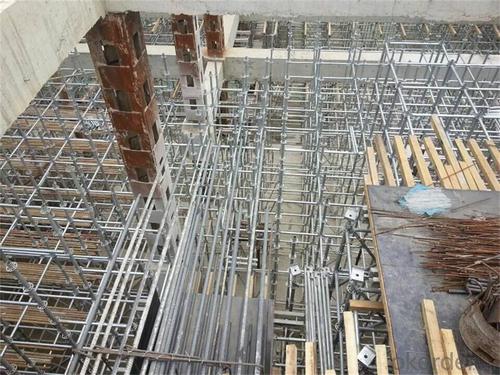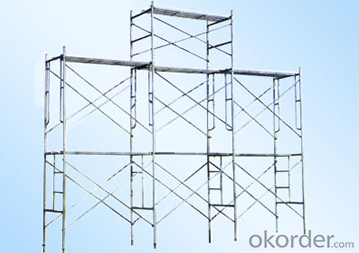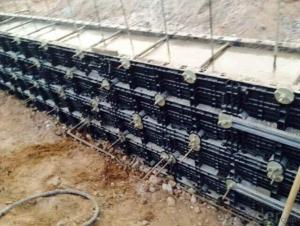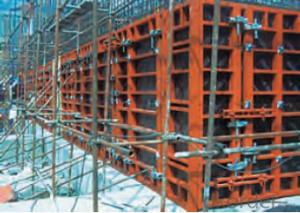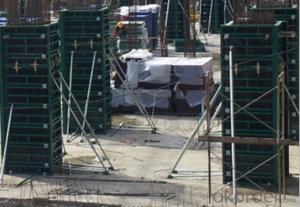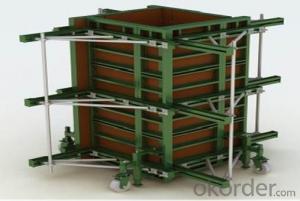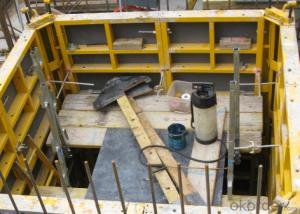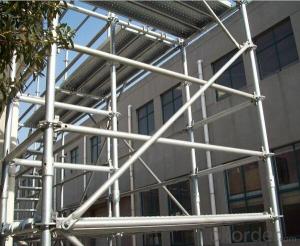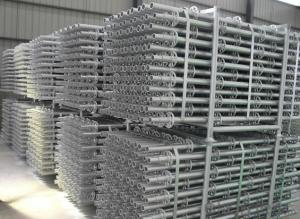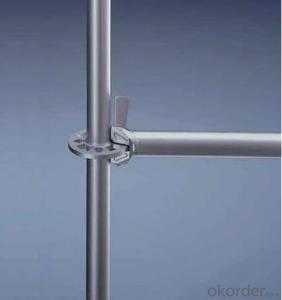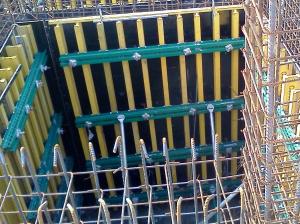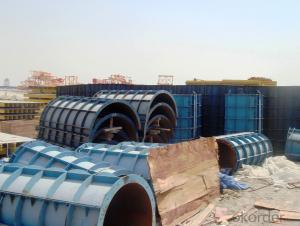RingLock Scaffolding with Cold Galvanized Surface Processing
- Loading Port:
- Shanghai
- Payment Terms:
- TT OR LC
- Min Order Qty:
- 1000 m²
- Supply Capability:
- 100000 m²/month
OKorder Service Pledge
OKorder Financial Service
You Might Also Like
1.Structure of Ring lock Description
Ringlock Scaffolding system is the most popular used Scaffolding system in the world.It will greatly reduce the cost because of the following advantages
Packaging & Delivery
Packaging Details:
Pallet or bag or upon client's request
Delivery Detail:
35days
2.Main Features of Ringlock
It will greatly reduce the cost because of the following advantages
1)Using less pipes
2)Easy to install
3)It can be used again and again for nearly 20years
3.Ring lock product pictures:
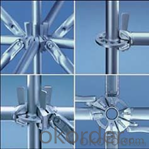
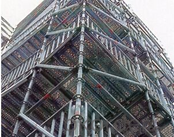
4.Ringlock Product Description
Type: ringlock scaffolding diagonal Brace
specification : Ø48.3×3.20
material:: steel Q235
Finished: Hot DIP galvanized, painted
Diagonal length(m) :Weight(kg)
0.9m * 1.25m 6.28
1.25m * 2.7m 11.45
5.FAQ
We have organized several common questions for our clients,may help you sincerely:
1)How about your company?
CNBM International Corporation, China National Building Materials (Group) Corporation, is one of the largest companies in China building material equipment industry, Our formwork and scaffolding are largely used in both domestic and all over world;
2)How many Scaffolding your company have?
Here comes our 5 types of Scaffolding systems:
- Cup lock Scaffolding(C-Lock Scaffolding)
- Ring lock Scaffolding
-Kwistage Scaffolding
-H-frame Scaffolding
-ID15 Scaffolding Tower, this type Scaffolding is the most widely used in construction, such like bridge.
3)How long can we receive the product after purchase?
Lead time is about 30days after getting the signed PI and deposit.
- Q: How does steel frame formwork contribute to the efficiency of the construction process?
- Steel frame formwork contributes to the efficiency of the construction process by providing a strong and durable structure that allows for faster and more accurate concrete pouring. Its lightweight nature allows for easy transportation and assembly, reducing construction time. Additionally, steel frame formwork can be easily adjusted and reused multiple times, saving costs and resources.
- Q: How does steel frame formwork affect the overall cost of a construction project?
- The overall cost of a construction project can be significantly impacted by the use of steel frame formwork. Although it may be more expensive at the beginning compared to traditional wood formwork, it provides several advantages that can lead to long-term cost savings. To begin with, steel frame formwork is highly durable and can be reused multiple times. Unlike wood formwork, which needs replacement after a few uses, steel formwork reduces the need for new materials and lowers construction costs. This reusability also minimizes waste and reduces the environmental impact of the project. Furthermore, steel formwork allows for faster construction. Its modular design and easy assembly enable quicker installation and dismantling, resulting in reduced labor costs and an accelerated construction process. This efficiency can lead to significant time savings, especially in large-scale projects, which translates into cost savings. Additionally, steel formwork ensures better quality control and precision in concrete placement. Its rigid structure guarantees accurate pouring of the concrete, eliminating the need for rework and reducing material wastage. This enhanced quality control prevents costly errors and delays, ultimately saving money. Moreover, steel formwork offers design versatility and customization. It can be easily adjusted and modified to meet specific project requirements, eliminating the need for specialized formwork systems. This adaptability reduces the necessity for additional formwork materials and simplifies the construction process, resulting in cost savings. Lastly, steel formwork requires minimal maintenance compared to wood formwork, which is prone to rot, warping, and other damages. The reduced maintenance and repair costs associated with steel formwork contribute to overall cost savings over the lifespan of the project. In conclusion, although steel frame formwork may have a higher initial cost, its durability, reusability, speed of construction, improved quality control, versatility, and minimal maintenance requirements can lead to significant cost savings throughout the construction project.
- Q: How does steel frame formwork help in achieving consistent concrete quality?
- Steel frame formwork is a construction technique that utilizes steel frames to support temporary molds or formwork for pouring concrete. This method provides numerous benefits, one of which is achieving consistent concrete quality. Firstly, steel frame formwork offers superior stability and rigidity compared to traditional timber formwork. The steel frames are designed to withstand the pressure exerted by the wet concrete, ensuring that the formwork holds its shape and does not deform or warp during the pouring process. This stability eliminates the risk of uneven surfaces or irregularities in the concrete, thereby contributing to a more consistent concrete quality. Moreover, the precise alignment and positioning of steel frame formwork play a crucial role in achieving consistent concrete quality. The steel frames are manufactured with high precision, allowing for accurate placement and alignment of the formwork. This precision ensures that the concrete is poured in the desired shape and dimensions, resulting in a uniform and consistent finish. Additionally, steel frame formwork provides a smooth and even surface for the concrete. The steel frames are typically coated or treated to prevent adhesion between the steel and concrete, allowing for easy removal of the formwork after the concrete has cured. This smooth surface helps to minimize surface defects and imperfections, thereby enhancing the overall quality and appearance of the concrete. Furthermore, steel frame formwork allows for efficient and controlled pouring of concrete. The formwork is designed to have adequate openings and access points for the placement of reinforcement bars and the pouring of concrete. This controlled pouring process helps to ensure that the concrete is evenly distributed, eliminating the risk of voids or weak spots in the structure. Overall, steel frame formwork is a highly reliable and efficient method for achieving consistent concrete quality. Its stability, precise alignment, smooth surface, and controlled pouring capabilities all contribute to a uniform and high-quality finish. By utilizing steel frame formwork, construction projects can minimize variations in concrete quality, resulting in stronger and more durable structures.
- Q: Does steel frame formwork require any specific joint sealing measures?
- Yes, steel frame formwork does require specific joint sealing measures. Joint sealing is necessary to ensure that the concrete being poured into the formwork does not leak or spill out through the joints. This can lead to poor concrete quality and compromised structural integrity. To prevent such issues, various joint sealing measures can be taken. One common method is to use joint sealing tapes or strips made of elastic materials, such as rubber or silicone, which are placed along the joints to prevent leakage. These tapes or strips are typically applied to both the inner and outer sides of the formwork joints. In addition to tapes, sealant compounds can also be used to fill any gaps or voids in the joints. These sealants are typically applied after the formwork is assembled and before the concrete is poured. They provide an additional layer of protection against leakage. It is important to ensure that the joint sealing measures are properly installed and maintained to prevent any potential issues during the concrete pouring process. Regular inspections should be conducted to identify any damage or wear to the joint sealing materials, and they should be repaired or replaced as necessary. Overall, joint sealing measures are crucial for steel frame formwork to ensure the successful containment of the concrete and to achieve the desired structural strength and durability.
- Q: Can steel frame formwork be used for both concrete walls and slabs?
- Yes, steel frame formwork can be used for both concrete walls and slabs. The steel frame provides stability and strength, making it suitable for various types of concrete structures.
- Q: How does steel frame formwork contribute to the overall flexibility of a construction project?
- Several benefits arise from the utilization of steel frame formwork, enhancing the overall flexibility of a construction project. Primarily, the high adaptability of steel frame formwork enables customization to meet the specific requirements of diverse construction projects. This flexibility facilitates the construction of structures with varying shapes and sizes, including buildings, bridges, and tunnels. Furthermore, the durability of steel frame formwork enables it to withstand the considerable pressure and loads encountered during construction. This durability allows for multiple reuses of the formwork, leading to reduced costs and time. Moreover, the ability to reuse the formwork permits adjustments and modifications during the construction process, providing greater flexibility in response to design changes or unforeseen circumstances. Additionally, steel frame formwork ensures a high level of accuracy and precision in the construction process. The formwork is designed to guarantee correct alignment and positioning of the concrete, resulting in consistent and high-quality finishes. This accuracy contributes to the overall flexibility of the project by facilitating efficient construction processes and minimizing the need for rework or corrections. Moreover, steel frame formwork incorporates enhanced safety features, such as built-in safety platforms and guardrails, creating a secure working environment for construction workers. This safety aspect reduces the risk of accidents or injuries, thereby allowing for greater flexibility in scheduling and executing construction activities. In conclusion, the utilization of steel frame formwork enhances the flexibility of construction projects through its adaptability, durability, accuracy, and safety. These advantages enable construction teams to efficiently execute tasks, make necessary adjustments, and ultimately deliver successful and flexible construction projects.
- Q: Can steel frame formwork be used in areas with limited material supply?
- Yes, steel frame formwork can be used in areas with limited material supply. Steel frame formwork is a versatile and durable construction system that is designed to withstand heavy loads and provide stability during the concrete pouring process. Unlike traditional timber formwork, steel frame formwork is reusable, which means it can be dismantled and reassembled multiple times, making it ideal for areas with limited material supply. Additionally, steel frame formwork can be easily transported and assembled onsite, reducing the need for extensive material supply.
- Q: How does steel frame formwork contribute to the overall waterproofing of a concrete structure?
- Steel frame formwork does not directly contribute to the overall waterproofing of a concrete structure. Its main purpose is to provide temporary support and shape to the concrete during construction. However, if the steel frame formwork is designed and installed properly, it can help ensure a precise and tight fit, which can indirectly contribute to the overall waterproofing by minimizing the potential for water leakage and improving the overall quality of the concrete structure.
- Q: What is the maximum permissible deflection of steel frame formwork panels?
- The maximum permissible deflection of steel frame formwork panels is typically specified by the manufacturer and can vary depending on the specific design and application. It is essential to consult the manufacturer's guidelines or industry standards to determine the exact maximum permissible deflection for a particular steel frame formwork panel.
- Q: Can steel frame formwork be used for healthcare facilities?
- Yes, steel frame formwork can be used for healthcare facilities. Steel frame formwork is a versatile and durable construction method that provides a high level of strength and stability, making it suitable for various types of buildings, including healthcare facilities. Healthcare facilities require robust and long-lasting structures to support the heavy equipment and machinery used in the medical field. Steel frame formwork offers the necessary strength to withstand the weight and stress associated with healthcare equipment. Furthermore, steel frame formwork allows for flexible design options, making it easier to accommodate the specific layout and requirements of healthcare facilities. The modular nature of steel frame formwork allows for easy customization, ensuring that the construction can adapt to the unique needs of healthcare facilities, such as operating rooms, patient rooms, laboratories, and other specialized areas. In addition to its strength and flexibility, steel frame formwork also provides excellent fire resistance, which is crucial for healthcare facilities. Steel has a high melting point, and when properly fireproofed, it can effectively withstand and contain fires, minimizing the risk of spreading and ensuring the safety of patients and staff. Overall, steel frame formwork is a suitable choice for healthcare facilities due to its strength, flexibility, and fire-resistant properties. By using this construction method, healthcare facilities can be built to withstand the demanding requirements of the medical field and provide a safe and durable environment for patients and healthcare professionals.
Send your message to us
RingLock Scaffolding with Cold Galvanized Surface Processing
- Loading Port:
- Shanghai
- Payment Terms:
- TT OR LC
- Min Order Qty:
- 1000 m²
- Supply Capability:
- 100000 m²/month
OKorder Service Pledge
OKorder Financial Service
Similar products
Hot products
Hot Searches
